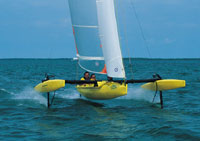|
How does it work?
The Rave has three T-foils, one under each outrigger and one under the
rudder. The foils of the outriggers and rudder have trimflaps, which are used to
control the flying height above the water. The trimflaps are operated
semi automatically:
- Sensitive sensors
drag through the water which measure the distance between the hull and
the surface of the water and which control the trimflaps. They only
operate over a specific range of windforce.
- The sailor operates
a set of bungee cords, that adjusts the operating range of the automatic
sensors: tightening the cords lowers the flying height (necessary when
the wind increases beyond the operating range of the sensors), letting
go increases the flying height (necessary when the wind decreases).
- When the windforce
is fairly constant, the bungee cords can be fastened and the Rave is
on automatic control by the sensors. Only when the windspeed varies,
the bungee cords must be handled.
- The flap on the
rudder is being operated through a joystick, changing the pitch of the
boat for more speed or easier take-off.
The steering is done
with the feet so that the sailor has both hands free which allows him
to adjust the sails, control the bungees or to wave at other (slower) sailors.
While sailing you
loose the bungees completely, letting the foils create maximum lift. At
take-off speed you gently put tension on the bungees to level the Rave.
Sheet in the jib sheet, the nose goes down and away you are. It is like
putting on the after-burner. The hissing of the foils is the only sound
you hear. Because the apparent wind is blowing head on, you can sheet in
your main and jib. It's like sailing on ice. Speeds up to 1,75 times the
true windspeed are possible.
Once you've got the
feeling how to operate the foils it's very easy because you don't need
to do any acrobatics in order to keep the boat upright. It is almost impossible
to capsize the boat. The boat is fun for people of all ages. And she is faster then any
other production sailboat, of course, when there is enough wind (she starts flying from
a windspeed of 7 -8 knots when the crew weight is 30 - 50 kg - see specifications)
The chance of damaging the boat is very small because the hulls are made
out of durable polyethylene and the foils and beams are made out of a special
grade aircraft aluminium.
Once flying you'll
need to be careful. The tendency of heading up during a gust of wind must
be suppressed. The boat could jump out of the water. The
right thing to do is bearing away and put more tension on the bungees.
Turning is easier by gybing, rather than tacking because that way the Rave will keep flying.
Making a flying gybe creates awesome G-forces similar to flying a
stunt-plane!
Safety note: We do
not recommend that this boat be sailed at extreme speeds without
considering the risks involved. At extreme speeds, this boat must
be considered as any racecar. The manufacturer does not guarantee
the boat above the speed of 26 knots (30 mph)
|



